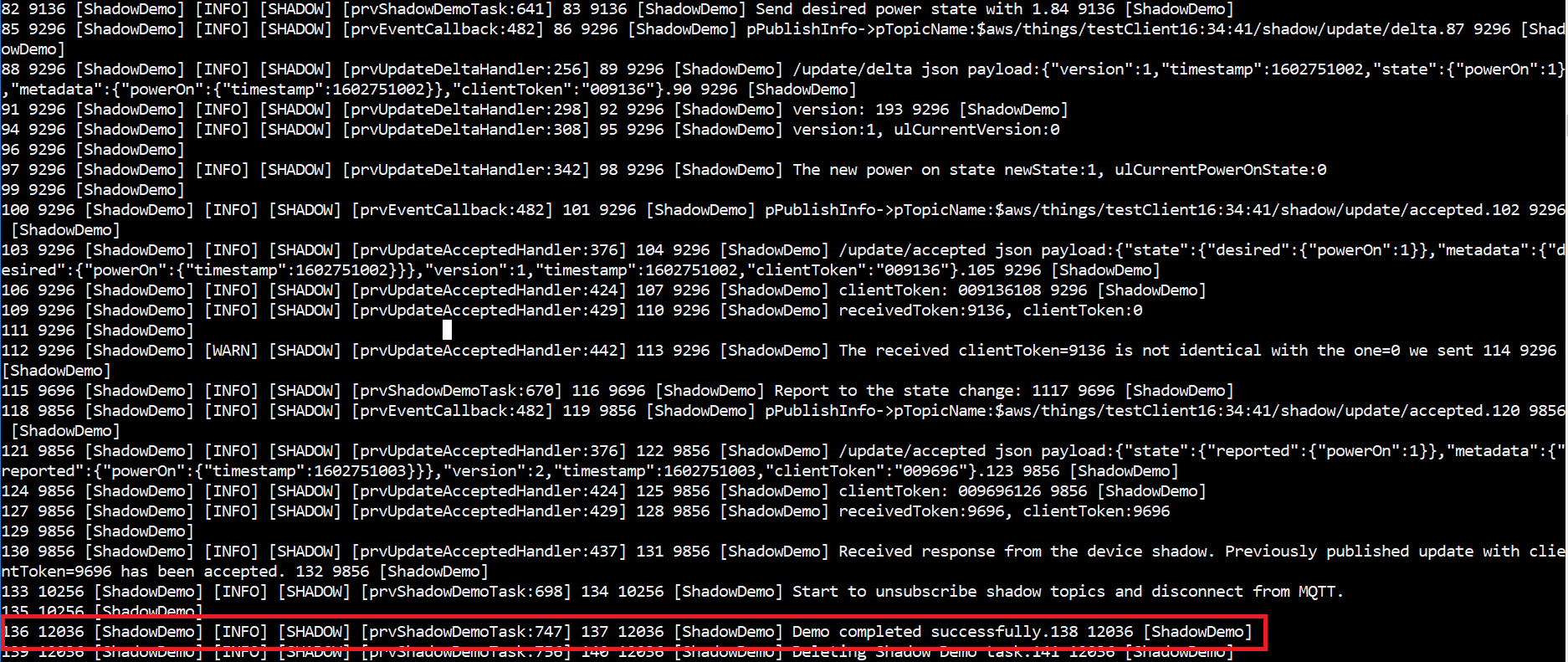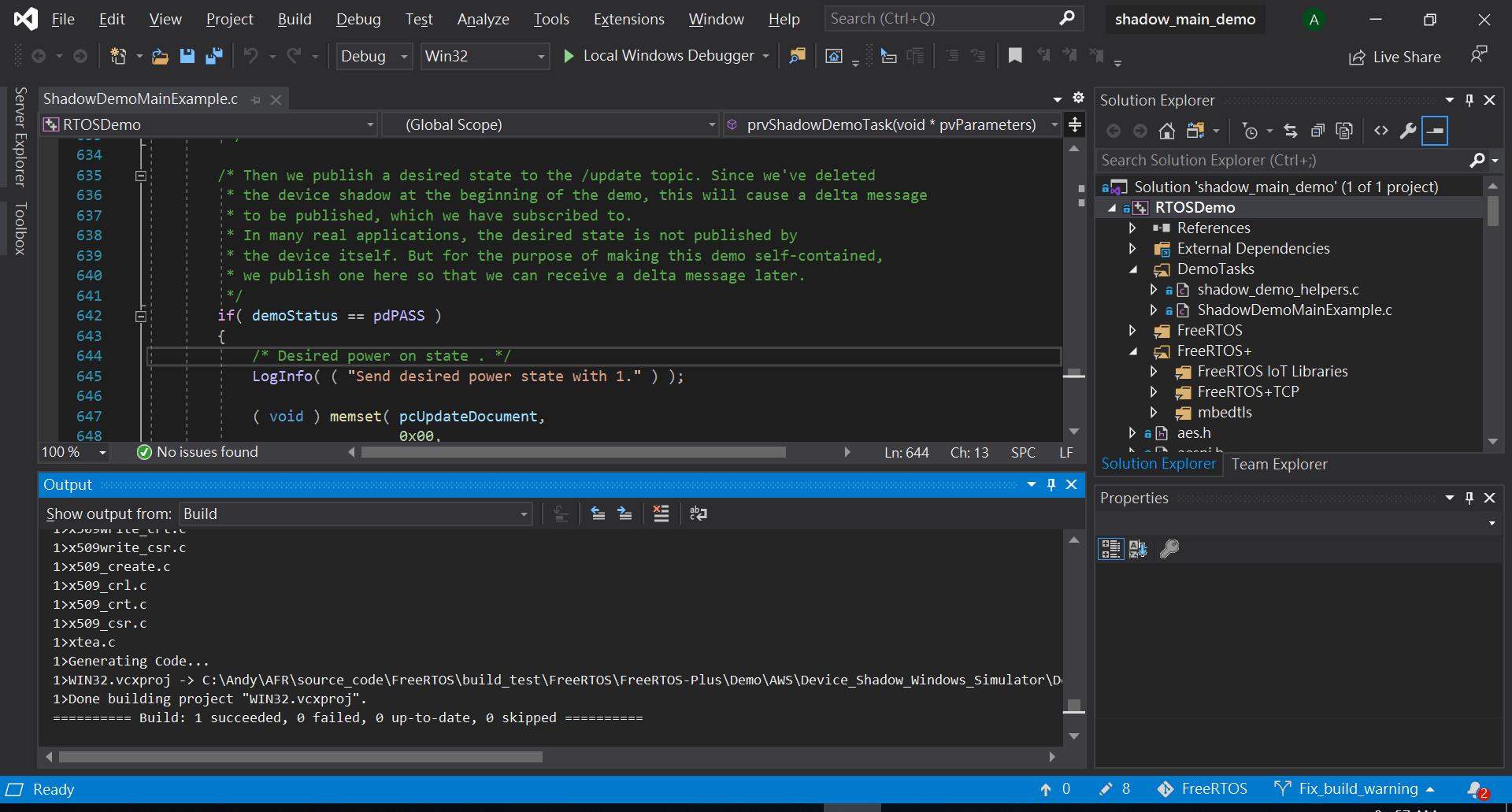AWS IoT Device Shadow demo application
Important
This demo is hosted on the Amazon-FreeRTOS repository which is deprecated. We recommend that you start here when you create a new project. If you already have an existing FreeRTOS project based on the now deprecated Amazon-FreeRTOS repository, see the Amazon-FreeRTOS Github Repository Migration Guide.
Introduction
This demo shows how to use the AWS IoT Device Shadow library to connect to the AWS Device Shadow service. It
uses the coreMQTT library to establish an MQTT connection with TLS (Mutual
Authentication) to the AWS IoT MQTT Broker and the
coreJSON library parser to
parse shadow documents received from the AWS Shadow service. The demo shows basic
shadow operations, such as how to update a shadow document and how to delete a shadow
document. The demo also shows how to register a callback function with the coreMQTT
library to handle messages like the shadow /update and
/update/delta messages that are sent from the
AWS IoT
Device Shadow service.
This demo is intended as a learning exercise only because the request to update the shadow document (state) and the update response are done by the same application. In a realistic production scenario, an external application would request an update of the state of the device remotely, even if the device is not currently connected. The device will acknowledge the update request when it is connected.
Note
To set up and run the FreeRTOS demos, follow the steps in Get Started with FreeRTOS.
Functionality
The demo creates a single application task that loops through a set of examples that
demonstrate shadow /update and /update/delta callbacks to
simulate toggling a remote device's state. It sends a shadow update with the new
desired state and waits for the device to change its
reported state in response to the new desired state. In
addition, a shadow /update callback is used to print the changing shadow
states. This demo also uses a secure MQTT connection to the AWS IoT MQTT Broker, and
assumes there is a powerOn state in the device shadow.
The demo performs the following operations:
-
Establish an MQTT connection by using the helper functions in
shadow_demo_helpers.c. -
Assemble MQTT topic strings for device shadow operations, using macros defined by the AWS IoT Device Shadow library.
-
Publish to the MQTT topic used for deleting a device shadow to delete any existing device shadow.
-
Subscribe to the MQTT topics for
/update/delta,/update/acceptedand/update/rejectedusing helper functions inshadow_demo_helpers.c. -
Publish a desired state of
powerOnusing helper functions inshadow_demo_helpers.c. This will cause an/update/deltamessage to be sent to the device. -
Handle incoming MQTT messages in
prvEventCallback, and determine whether the message is related to the device shadow by using a function defined by the AWS IoT Device Shadow library (Shadow_MatchTopic). If the message is a device shadow/update/deltamessage, then the main demo function will publish a second message to update the reported state topowerOn. If an/update/acceptedmessage is received, verify that it has the sameclientTokenas previously published in the update message. That will mark the end of the demo.

The demo can be found in the file
freertos/demos/device_shadow_for_aws/shadow_demo_main.c
The following screenshot shows the expected output when the demo succeeds.

Connect to the AWS IoT MQTT broker
To connect to the AWS IoT MQTT broker, we use the same method as MQTT_Connect() in the
coreMQTT mutual authentication demo.
Delete the shadow document
To delete the shadow document, call xPublishToTopic with an empty message, using macros defined
by the AWS IoT Device Shadow library. This uses MQTT_Publish to publish to the /delete
topic. The following code section shows how this is done in the function prvShadowDemoTask.
/* First of all, try to delete any Shadow document in the cloud. */ returnStatus = PublishToTopic( SHADOW_TOPIC_STRING_DELETE( THING_NAME ), SHADOW_TOPIC_LENGTH_DELETE( THING_NAME_LENGTH ), pcUpdateDocument, 0U );
Subscribe to shadow topics
Subscribe to the Device Shadow topics to receive notifications from the AWS IoT broker
about shadow changes. The Device Shadow topics are assembled by macros defined in the
Device Shadow library. The following code section shows how this is done in the
prvShadowDemoTask
function.
/* Then try to subscribe shadow topics. */ if( returnStatus == EXIT_SUCCESS ) { returnStatus = SubscribeToTopic( SHADOW_TOPIC_STRING_UPDATE_DELTA( THING_NAME ), SHADOW_TOPIC_LENGTH_UPDATE_DELTA( THING_NAME_LENGTH ) ); } if( returnStatus == EXIT_SUCCESS ) { returnStatus = SubscribeToTopic( SHADOW_TOPIC_STRING_UPDATE_ACCEPTED( THING_NAME ), SHADOW_TOPIC_LENGTH_UPDATE_ACCEPTED( THING_NAME_LENGTH ) ); } if( returnStatus == EXIT_SUCCESS ) { returnStatus = SubscribeToTopic( SHADOW_TOPIC_STRING_UPDATE_REJECTED( THING_NAME ), SHADOW_TOPIC_LENGTH_UPDATE_REJECTED( THING_NAME_LENGTH ) ); }
Send Shadow Updates
To send a shadow update, the demo calls xPublishToTopic with a message in
JSON format, using macros defined by the Device Shadow library. This uses
MQTT_Publish to publish to the /delete topic. The
following code section shows how this is done in the prvShadowDemoTask
function.
#define SHADOW_REPORTED_JSON \ "{" \ "\"state\":{" \ "\"reported\":{" \ "\"powerOn\":%01d" \ "}" \ "}," \ "\"clientToken\":\"%06lu\"" \ "}" snprintf( pcUpdateDocument, SHADOW_REPORTED_JSON_LENGTH + 1, SHADOW_REPORTED_JSON, ( int ) ulCurrentPowerOnState, ( long unsigned ) ulClientToken ); xPublishToTopic( SHADOW_TOPIC_STRING_UPDATE( THING_NAME ), SHADOW_TOPIC_LENGTH_UPDATE( THING_NAME_LENGTH ), pcUpdateDocument, ( SHADOW_DESIRED_JSON_LENGTH + 1 ) );
Handle shadow delta messages and shadow update messages
The user callback function, that was registered to the coreMQTT
Client LibraryMQTT_Init function, will notify us about an incoming packet event.
See the callback function
prvEventCallback
The callback function confirms the incoming packet is of type MQTT_PACKET_TYPE_PUBLISH, and uses
the Device Shadow Library API Shadow_MatchTopic to confirm that the incoming message is a shadow
message.
If the incoming message is a shadow message with type ShadowMessageTypeUpdateDelta, then we call
prvUpdateDeltaHandlerprvUpdateDeltaHandler uses
the coreJSON library to parse the message to get
the delta value for the powerOn state and compares this against the current device state maintained
locally. If those are different, the local device state is updated to reflect the new value of the
powerOn state from the shadow document.
If the incoming message is a shadow message with type ShadowMessageTypeUpdateAccepted, then
we call
prvUpdateAcceptedHandlerprvUpdateAcceptedHandler parses
the message using the coreJSON library to get the
clientToken from the message. This handler function checks that the client token from the JSON message
matches the client token used by the application. If it doesn't match, the function logs a warning message.